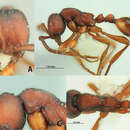Description
provided by Zookeys
(holotype and paratypes). Head in full-face view elliptical, clearly longer than broad, with sides convex and posterior margin almost straight or weakly convex; occipital margin forming a distinct carina; seen in profile occipital corner of head rounded. Antennal scape relatively long, extending 3/4 of head length; antennal segment II almost as long as each of III-VI; terminal segment slightly shorter than VII+VIII+IX. Frontal carinae short fused at the level of antennal base to form a single carina and slightly extending beyond 1/4 of head length, poorly developed in posterior half. Parafrontal ridge short, extending less than 1/3 of head length, 0.30–0.33 mm long. Masticatory margin of mandible with a series of 6–7 denticles of same size; basal margin of mandible lacking denticles. Mesosoma in profile with promesonotum convex dorsally and sloping gradually to metanotal groove; metanotal groove indistinct compared with those of the other members of the group; mesonotum demarcated from mesopleuron by a conspicuous ridge. Propodeum almost flat or weakly convex dorsally; declivity of propodeum shallowly concave, encircled with a developed rim; seen in profile dorsal portion of the rim protruding posteriad. Petiole subsessile, slightly longer than high, its dorsal outline elevated posteriorlly; subpetiolar process very low, its ventral outline weakly convex; postpetiole longer and larger than petiole and slightly longer than high, with its dorsal outline convex. Legs relatively long with apical halves of femora and tibiae somewhat swollen.
Head entirely finely punctate; mandible very finely striate except along masticatory margin; antennal scape finely punctate. Pronotum entirely punctate; mesopleuron, metapleuron and lateral face of propodeum punctate; dorsal face of propodeum finely punctate. Petiole entirely punctate; postpetiole punctate with weakly sculptured and shiny anterior slope of node. Basal half of femora densely punctate but apical half superficially macroreticulate and shiny; tibiae macroreticulate and shiny.
Head and mesosoma dorsally with sparse standing hairs mixed with very short hairs; longest pronotal hair 0.25–0.28 mm long. Entire body dark reddish brown. Typhlatta spots absent.
- license
- cc-by-3.0
- copyright
- Weeyawat Jaitrong, Seiki Yamane
- bibliographic citation
- Jaitrong W, Yamane S (2012) Review of the Southeast Asian species of the Aenictus javanus and Aenictus philippinensis species groups (Hymenoptera, Formicidae, Aenictinae) ZooKeys 193: 49–78
- author
- Weeyawat Jaitrong
- author
- Seiki Yamane
Distribution
provided by Zookeys
Borneo (Sabah, Sarawak, Brunei, and E. Kalimantan) and Java (Fig. 12).
- license
- cc-by-3.0
- copyright
- Weeyawat Jaitrong, Seiki Yamane
- bibliographic citation
- Jaitrong W, Yamane S (2012) Review of the Southeast Asian species of the Aenictus javanus and Aenictus philippinensis species groups (Hymenoptera, Formicidae, Aenictinae) ZooKeys 193: 49–78
- author
- Weeyawat Jaitrong
- author
- Seiki Yamane

